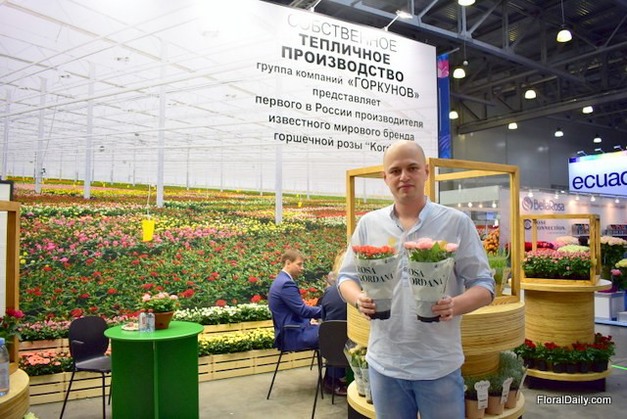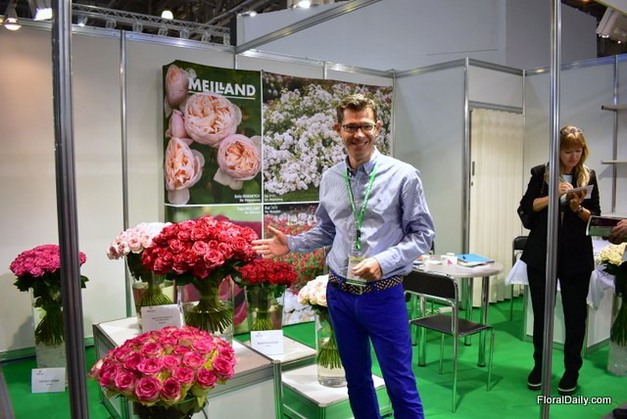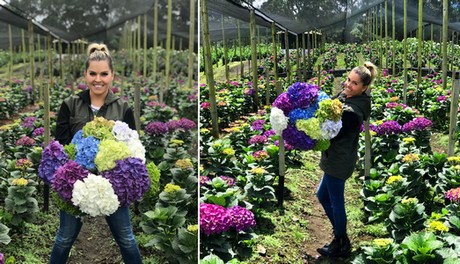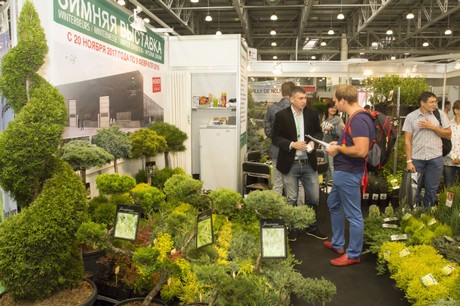In recent years, the Russian government has made self-sufficiency a top priority. This has already resulted in a large number of new greenhouse projects for vegetable cultivation. But also in flowers and plants, Russia aims to become less dependent on imports. That's not all bad news for foreign companies, however. The expansion of domestic growers opens up opportunities for suppliers from other countries, while Russia's increasingly affluent population drives up demand for flowers and plants, both from within the country and abroad.
It's not just vegetable greenhouses that are popping up across the country - Russian ornamental growers are doing good business too, expanding for the sake of self-sufficiency. For instance, a new greenhouse in Saint Petersburg is to meet up to 60% of the city's demand in flowers for flowerbeds. A few months later, in June 2018, construction of a tulip greenhouse near Smolensk was announced. Other recent expansions include a rose greenhouse in North Ossetia, while a rose grower near Moscow just announced a 6 hectare expansion.
These are just a few examples that show how the flower business in Russia is stabilizing - a development also noticed by the organizers of the annual FlowersExpo, who are seeing an increasing number of domestic participants.

Opportunities for suppliers
These expansions offer chances for suppliers. One such supplier, Schneider, is seeing constant growth in the Russian market. As Zsófia Simó, marketing & communication specialist at the company, told us ahead of the FlowersExpo: "Russian growers [...] always strive to expand their businesses and Schneider youngplants is happy to provide valuable knowledge and advice in order to allow them to reach their goals."

This sentiment was echoed on the trade show floor, where it became apparent that several growers were expanding or planning to expand their greenhouses. In turn, the breeders at the show also reported seeing an increasing interest for their varieties from the Russian growers.
The number of growers in Russia seems to be growing as well. "In the last five years, the quantity of farms has grown, and it is now bigger than 10 years ago. Every year, new producers and farms pop up", a Russian grower told us. In order to make this all happen, growers receive financial support from the government.
European know-how
The increasing number and size of Russian companies is good news for European companies. "In order to produce a good quality product, many growers invite Dutch horticulturalists for advice", the aforementioned grower continues. And Dutch Agricultural Counsellor Meeuwes Brouwer confirms this. He informed us that the drive to become more self-sufficient results in a need for Dutch knowledge, products and techniques. "The demand for Dutch starting material, for example, increased by 25%."

One example is Zheleny Dom. This outdoor rose grower tests a lot of varieties from Dutch and German breeders. The company grows roses on 5 hectares, not only in the open field, but also in several greenhouses. In 2019 the new 4.5 hectare greenhouse will be ready.

Another Russian company, Da!Rosa, grows several Kordana varieties, from German breeder Kordes Roses. Denis Kolpakov of Da!Rosa, sees the number of Russian ornamental growers increase as well. Finding qualified staff can be difficult though, which is why Russian farms are bringing in Dutch growers to give advice.
Export opportunities
While the quest for self-sufficiency has only just begun, there are still opportunities for flower exporters to Russia. After all, it's a flower-loving country, whose appetite for ornamentals isn't easily satiated. We'll highlight some crops in more detail.
Roses
According to Eurostat figures, Russia is the biggest non-EU market for EU roses, at €28 million (45% of the total extra-EU exports of roses). The biggest suppliers of roses to Russia are traditionally Colombia and Ecuador, however - although both countries have seen demand slide a bit.

"Several years ago, Russia was a very important market to us, but since the crisis, the volumes and prices dropped. We therefore decided to focus more on other markets, like the US and Europe", George Ortega of Colombian rose farm Matina Flowers explains. "We used to sell about 35-40 percent of our volume to Russia, but due to the crisis, the volumes and prices decreased drastically. We see the volumes recovering slowly, about 1.5 percent increase in volume a year, but volumes remain low. And personally, I do not think, they will reach their old levels again." Currently about 8 to 12 percent of their volume goes to the Russian market.

Ecuadorian rose grower Eco Roses also reduced its exports to Russia, but it is still an important market to them; around 30 percent of their production volume goes to this market.

So while Russia is still a significant market for Latin American countries, a gap is opening up - and others are ready to fill it. Klaus Wolf of Rosen Tantau, on the other hand, sees the Russian market growing. "They love roses and red is still the most popular color (40%) followed by white (20-25%)", he told us at the FlowersExpo. And according to Damien Cabaret of Meilland, there is a high potential for local growers. At this year’s FlowerExpo, the French breeder showed only scented garden type cut roses. “These are challenging to ship, but therefore offer an opportunity for local growers to diversify themselves from the imported flowers.”

Chrysanthemums
Another Russian favorite is the chrysanthemum. Traditionally, disbudded chrysanthemums were the best sellers in Russia, but over the last few years the demand has shifted to spray chrysanthemums and santinis, Danny van Uffelen of Zentoo says. Russia is their major market and due to the change in demand, they changed the assortment of their Zentoo-branded mums accordingly.

Russia is a chrysanthemum-loving country, and most of the chrysanthemums sold in Russia are imported from the Netherlands.
And the Russian consumer seems to have money to spend again. "The prices are about 30 percent higher compared to last year, which was a mediocre year. [...] This year, growers focused on a more stable supply, and the lack of summer flowers on the market might uplift the demand for chrysanthemums even further."
Tulips
The tulip is always in short supply, according to John Elstgeest of Flower Circus. This means there's always a shortage of Russian tulips, making import necessary. "Despite the fact that Dutch tulips are a bit shorter, lighter and less mature than Russian tulips, they do well", John says, analyzing the market ahead of Women's Day. In order to meet the increasing demand, domestic tulip growers are also expanding their acreage.

Cut flowers
While roses, mums and tulips are the most popular flowers, Russians appreciate cut flowers of all sorts. Flower consumption is traditionally high, but when the rouble goes down, like last year, normally expensive flowers get an extra push, as evidenced by figures from Royal FloraHolland.
John Elstgeest also noticed a shift away from just the traditional top three, seeing more summer flowers, as well as muscaris, hellebores and roses from Ecuador and Africa, with shorter stems.

Colombian carnation grower Turflor is one of the parties to benefit from this trend. “Around 8 percent of our production is going to Russia. There we see a trend towards more smaller flowers in large bouquets”, according to CEO Mauricio Briceño.
Hydrangeas
It's not just about smaller flowers though. Russian consumers looking to make a statement can also go for hydrangeas. According to Catalina Arango, Commercial Director at Colombian hydrangea grower Flores del Este, Russia is an interesting market for hydrangeas from Colombia, since it grew 44.1 % in value and 52.5% in volume.

“I believe that flowers for the Russians are still a very important and essential attribute of holidays, family events and public celebrations. And despite the crisis of the past years the demand for flowers is still at a sufficiently high level”, she says.
Phalaenopsis
The Russian market for phalaenopsis orchids has been stable for many years now, but Mischa Groothuizen of Levoplant still sees potential for development. The Dutch phalaenopsis nursery has been supplying this market for about a decade now, and sees room for improvement in two main areas: transportation and presentation.

"From the Netherlands to Moscow, it takes about three days and then, some need to travel even further to the smaller cities surrounding. On top of that, they are repacked." It all affects the quality of the product. "Fortunately, the quality of our phalaenopsis is high when leaving the nursery, but it’s also necessary to keep this quality during transport."
Next to transportation, presentation can be an important point to increase the sales in this country. "We are exhibiting at the FlowersExpo for about nine years now and we see that all visitors at the exhibition love phalaenopsis. However, when visiting flower shops or retail stores, we see that the phalaenopsis aren't presented to their full potential. There is a lot to gain when we could address this locally."
Garden plants
Russians love cut flowers, but the annual exodus to the dacha in summer shows they're also fans of a bit of gardening and the accompanying plants. Poland is the largest supplier of ornamental plants to Russia, so it's no wonder the company had a large presence at the FlowersExpo this year.

The top sellers in the garden plants segment, according to Schneider, are Begonias, Petunias, Coleus, Ageratum and Pansy varieties. "The customers are always looking for new colors and varieties, thus Schneider youngplants will be presenting the newest additions to their assortment at the show alongside its most popular products (annuals, biannuals and perennials included)", Zsófia Simó commented ahead of the show.
Conclusion
Just like the greenhouse vegetable sector, the floriculture industry in Russia is also growing fast. Expansion at domestic companies creates opportunities for suppliers, while the increasingly affluent flower-loving consumers ensure a fertile market for foreign producers of ornamentals.
